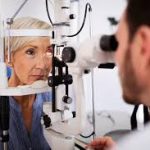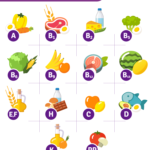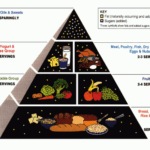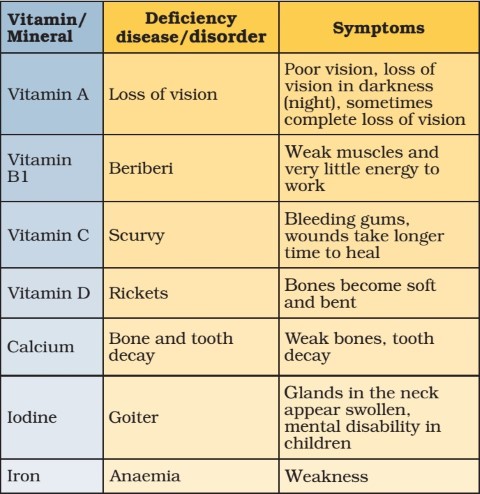Vitamins and Their Functions Sources and Deficiency Chart
Vitamins are essential nutrients in small doses. They are found in a wide variety of foods. They are important in preventing certain diseases and maintaining good health.
They perform many functions, from boosting immunity to stabilizing blood sugar. They also serve as coenzymes or antioxidants. Some — like vitamin D and retinoids (retinal, zeaxanthin and lutein) — function as hormones.
A Vitamin
Vitamin A (also known as retinol) plays an important role in eye health, bone growth and development, cell reproduction, and gene expression. Vitamin A is also a strong antioxidant and helps protect against some cancers.
Water-soluble vitamins, such as the B-complex and vitamin C, are not stored in the body so must be consumed daily. They can be found in a variety of foods including enriched grains, meats, fish, eggs, dairy products, legumes and fresh fruits.
Deficiencies of most vitamins are rare in the United States. However, deficiencies may occur in some people with restrictive diets or certain health conditions that interfere with vitamin absorption.
B Vitamin
The B vitamins are water-soluble and help the body get energy from food and form red blood cells. They include thiamine, riboflavin, pantothenic acid, biotin, vitamin B6, folate and cobalamin.
B vitamins are found in protein foods, dairy products, leafy green vegetables, beans and many whole and fortified cereals. The vitamin B complex is especially important for pregnant women and those who might become pregnant. It contains the necessary nutrients folic acid and vitamin B12. At high levels, some B vitamins can be toxic. Deficiencies are uncommon in people who eat varied diets.
C Vitamin
Vitamin C is a water-soluble nutrient that’s used in small amounts daily by the body. It functions as an antioxidant and also has triglyceride-lowering effects at higher doses.
It protects essential molecules from damage caused by free radicals and other reactive oxygen species that are generated during normal metabolism and through exposure to toxins (e.g., cigarette smoke).
Deficiency of this vitamin is rare in the United States. Its requirements increase during illness, pregnancy and in people who drink excessive amounts of alcohol. Good dietary sources include liver, poultry, eggs, vegetables and whole grains.
D Vitamin
Vitamin D, commonly known as the “sunshine vitamin,” is made in the skin by exposure to sunlight. It also is found in fatty fish, dairy products and fortified margarine.
Serum 25(OH)D levels rise with increased dietary intakes, but there is some variability [1,2]. Several studies suggest that lower vitamin D status may be associated with an increased risk of cardiovascular disease, notably stroke and myocardial infarction.
Water-soluble vitamins move freely through the body and excess amounts are excreted in urine. However, high doses of some water-soluble vitamins, such as niacin and folate, can be toxic.
E Vitamin
Vitamin E acts as an antioxidant to protect cells and tissue from free radical damage. It is available in a variety of foods, including almonds and vegetable oils. It is also available in supplements as tocotrienols or gamma-tocopherols. Research has suggested that vitamin E may reduce the risk of cataracts and slow the onset of Alzheimer’s disease.
Deficiency of some vitamins can cause serious illness. Vitamin D deficiency causes rickets in children, while a lack of thiamine can lead to beri beri and pellagra. These deficiencies are prevented by adequate intakes of the vitamins in the diet and supplements.
K Vitamin
The K vitamin (“K” stands for coagulation) plays an important role in blood clotting. It also supports bone health and prevents the calcification of kidneys and blood vessels. Vitamin K1 (phylloquinone) is found mostly in plant foods, while vitamin K2 (menaquinones) is produced by bacteria that normally colonize the large intestine and is also found in animal products and fermented soy products.
In a long-term observational study, high intake of phylloquinone was associated with lower rates of knee osteoarthritis. This is possibly due to vitamin K’s role in blood clotting and the formation of osteocalcin, which is necessary for bone health.
P Vitamin
There are 13 vitamins currently recognized as essential to human health. People get most of these from a balanced diet, with dietary supplements recommended for pregnant women and others with particular health concerns or food restrictions.
Vitamin A (retinol) functions to promote healthy eyes and is a powerful antioxidant. It also aids the formation of keratin, a protein found in skin and hair. Good sources include liver, cod liver oil, leafy vegetables, carrots and apricots.
Folic acid, vitamin B9, is important for a healthy nervous system. It prevents certain anemias and helps the body make DNA and RNA. It is found in leafy vegetables, legumes, liver and some fortified foods.
Q Vitamin
Vitamins are essential to humans in small quantities but cannot be synthesized by the body. They must be ingested in food or supplements. Too much can be toxic.
The most common vitamins are A, C and E. A, D and K are fat soluble while B-group are water soluble.
Vitamins are organic molecules and some of them act as hormone-like substances. Others act as antioxidants, some have coenzyme-like functions and the largest group, B complex vitamins, act as enzyme helpers called coenzymes. Vitamins are usually measured in microgram or milligram (mg) amounts.
R Vitamin
The R Vitamin, also known as vitamin K, plays a role in blood clotting. It can be found in liver, fish oil, whole grains, dark green vegetables, and some nuts.
People do not store water soluble vitamins, so they must consume a balanced diet that includes foods from all groups daily. Vitamin deficiency is rare, except in the elderly, alcoholics, and those on limited diets. Deficiency of fat soluble vitamins can lead to serious illness, such as pellagra (niacin deficiency). Excess intake of some vitamins can cause toxicity.
S Vitamin
Also known as folic acid or vitamin B9. It is vital for cell growth and reproduction. Low levels can cause neurological problems and some types of anemia. Good sources include liver, broccoli and leafy vegetables, some fortified grains and nuts.
Vitamins are organic molecules that cannot be synthesized in sufficient quantities by an organism for survival and must be obtained through the diet. They are grouped into two groups: water-soluble vitamins and fat-soluble vitamins. Many have common names and chemical names, and some have multiple forms (vitamers). Each performs a different function.







